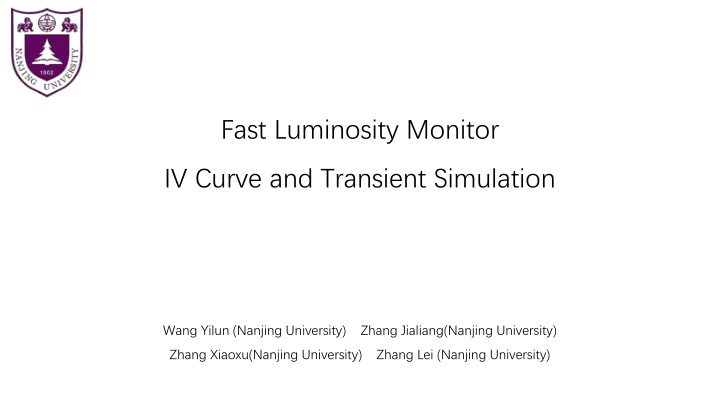
Fast Luminosity Monitor: IV Curve and Transient Simulation
Explore the development of a fast luminosity monitor for CEPC, detailing the IV characteristic curve, geometry design, doping process, and physics behind the I-V curves. Learn about the use of diamond detectors, transient simulations, and high carrier mobility in this cutting-edge technology.
Download Presentation

Please find below an Image/Link to download the presentation.
The content on the website is provided AS IS for your information and personal use only. It may not be sold, licensed, or shared on other websites without obtaining consent from the author. If you encounter any issues during the download, it is possible that the publisher has removed the file from their server.
You are allowed to download the files provided on this website for personal or commercial use, subject to the condition that they are used lawfully. All files are the property of their respective owners.
The content on the website is provided AS IS for your information and personal use only. It may not be sold, licensed, or shared on other websites without obtaining consent from the author.
E N D
Presentation Transcript
Fast Luminosity Monitor IV Curve and Transient Simulation Wang Yilun (Nanjing University) Zhang Jialiang(Nanjing University) Zhang Xiaoxu(Nanjing University) Zhang Lei (Nanjing University)
Contents Introduction Geometry & Doping I-V Characteristic Curve Transient Simulation Conclusion
Introduction Fast Luminosity Monitor is used to give bunch luminosity at CEPC Integrated event rates along z-position can help monitoring z-position at IP Polar angle ?~10 ????, highest radiation field at CEPC Detect small angle Bhabha events Electron showers generated in the copper beam pipe Diamond is used for detector Single crystal Chemical Vapor Deposition (sCVD), reducing defect densities High carrier mobility : 2000~2800 ??2? 1? 1 Wide bandgap, low dark noise : 5.47 ?? Strong covalent bonds, high radiation hardness 3 3
Geometry Design for transient simulation testing later 2000 2000 500 ?? (x y z) 1 ?? Two electrodes on front side, each 900 1900 ?? (? ?) 10 ?? One on back side, 1900 1900 ?? (? ?) 4 4
Doping During CVD process, Boron and Nitrogen are common impurities Boron Concentration Carrier Concentration (Boron Active Concentration ) Add 1010 Boron Active Concentration 5 5
I-V Characteristic Curve - Physics Physics { EffectiveIntrinsicDensity( OldSlotboom ) # doping bandgap narrowing effect Mobility( -ConstantMobility DopingDep HighFieldSaturation( Eparallel ) Enormal ) Recombination( SRH( DopingDep ) Avalanche ) Temperature=298 Hydrodynamic } # do not use ConstantMobility model # mobility degradation at interfaces # doping dependent Shorkley-Read-Hall recombination 7 7
I-V Characteristic Curve - Physics Physics { EffectiveIntrinsicDensity( OldSlotboom ) Mobility( -ConstantMobility DopingDep HighFieldSaturation( Eparallel ) Enormal ) Recombination( SRH( DopingDep ) Avalanche ) Temperature=298 Hydrodynamic } 8 8
I-V Characteristic Curve 2 Electrodes on front side Half the current Doping : 1010?? 3 Boron (Boron Active Concentration) 9 9
I-V Characteristic Curve With hydrodynamic physics model, the current is slightly higher 10 10
Transient Simulation 11 11
Transient Simulation - Physics Physics { EffectiveIntrinsicDensity( OldSlotboom ) Mobility( -ConstantMobility DopingDep HighFieldSaturation( Eparallel ) Enormal ) Recombination( SRH( DopingDep ) Avalanche ) Temperature=298 Hydrodynamic HeavyIon( Direction= (0,0,1) Location = (0,0,-260) Time = 1e-9 Length = 520 Wt_hi = 1 LET_f = 5.767e-6 Gaussian PicoCoulomb ) } Simulation of electron hit From (0, 0, -260) to (0, 0, 260), penetrate the detector Wt_hi : radius same as IV simulation 1 ?? LET_f : linear energy transfer 5.767 10 6??/?? Gaussian : uses Gaussian distribution instead of exponential distribution PicoCoulomb : specifies the unit to be ?? and ??/?? for Wt_hi and LET_f respectively 12 12
Transient Simulation Center Hit HeavyIon( Direction = (0,0,1) Location = (0,0,-260) Time = 1e-9 Length = 520 Wt_hi = 1 LET_f = 5.767e-6 Gaussian PicoCoulomb ) With hydrodynamic physics model, the current is slightly higher 13 13
Transient Simulation ? = 24.3 ???? 2 1 ? 14 14
Conclusion Fast luminosity monitor uses sCVD diamond, for its high carrier mobility, wide bandgap and high radiation hardness The geometry of detector for particle hit simulation is built, while doping is set to 1010?? 3 I-V characteristic curves are drawn, and the effect of adding hydrodynamic physics model is shown Transient simulations of particle hitting the detector are performed, the signal produced is drawn 15 15
